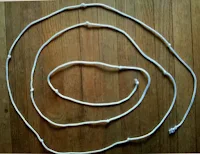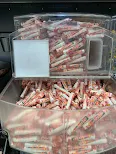Reading
As I delved into the reading on Surfing the Möbius Band, a
couple of significant 'stops' captured my attention, sparking a reflective
journey into the intersection of art and mathematics.
The first 'stop' arises when the authors discuss the formal
experiment in issue 11 of the Silver Surfer series, titled "The Moebius
Madness of Silver Surfer." The decision by Dan Slott and Mike Allred to
structure the storytelling using the form of a Möbius band is intriguing. The
Möbius band, known for its representation of change and renewal, becomes a
metaphor within the comic, symbolizing the cyclical nature of time and space in
the Marvel universe. This integration of mathematical concepts into the
narrative is a unique storytelling device and prompts a deeper reflection on
the character's existential journey. The Möbius band becomes a visual cue,
guiding readers through Silver Surfer's temporal loop and emphasizing the
importance of free will in breaking the cycle.
Another 'stop' occurs when the reading explores the broader
cultural impact of the Möbius band in fiction. The Möbius band, with its odd
topological properties, has been utilized in various stories to symbolize
either an endless loop or a mysterious transition to 'the other side.' Examples
from Star Trek to an Argentinean film illustrate the diverse ways in which this
mathematical figure has been woven into the fabric of storytelling. The reading
suggests that the Möbius band, beyond its mathematical accuracy, holds a
powerful place in the collective imagination, serving as a symbol for the
unending and the cyclical in literature and art.
As I reflect on these 'stops,' I wonder how readers perceive
the integration of mathematical concepts into the visual storytelling of
comics. Does this enhance or detract from their engagement with the narrative?
In conclusion, the reading not only explores the creative
use of mathematical concepts in comics but also raises questions about the
accuracy of these representations. The fascinating interplay between art and
mathematics in Silver Surfer's story prompts me to appreciate the beauty of
their union while recognizing the occasional discrepancies that arise when
mathematical symbols enter popular culture.
Activity
As I
immersed myself in Sarah Glaz's introduction to the Fibonacci poems for Bridges
2021, a pivotal moment emerged in the creative process and collaborative spirit
behind the collection.
Indeed, it
is the origin story of the Fib poems within the Bridges poetry community. The
virtual setting of the Bridges 2021 conference, designed as the town of
Königsberg with its seven bridges, became the catalyst for the poetry gathering
in the Glade. The challenge of limited time for over thirty poets led to the
ingenious idea of blink-poems, specifically Fibs. This creative solution, sparked
by Alice Major and refined through collaboration, not only facilitated a quick
read-around but also paved the way for forming a unique collection. It
highlights the adaptability and inventiveness that can arise when artistic
minds come together to navigate challenges.
Another
noteworthy 'stop' explains the Fibonacci sequence and how it translates into
Fib poems. Glaz provides a concise and clear understanding of the mathematical
underpinning of Fibs, tracing their syllable count back to the Fibonacci
numbers. However, I struggle to complete my poems below and will continue the
work when I feel more rested and inspired. This intersection of mathematics and
poetry adds depth to the creative process, emphasizing the harmonious blend of
two seemingly disparate disciplines. The structured nature of Fib poems,
derived from the Fibonacci sequence, presents a fascinating framework for poets
to explore and express their ideas.
Now, as I
reflect on these 'stops,' I wonder how the poetic form derived from the
Fibonacci sequence influences the thematic choices made by the poets. How do
they navigate the constraints of the form to convey their ideas effectively?
Algebraic
Equations
X
plus
Y makes Z
Solving for
the unknown
?????????????????????
Geometric
Points
Circles
spin
around
points
??????????????????????
Explanation:
For the first
Fib poem, "Algebraic Equations," I explored the realm of algebra and
the process of solving equations. The Fibonacci sequence determined the
syllable count in each line (1, 1, 2, 3, 5, 8), guiding the poem's structure.
In the second
Fib poem, "Geometric Points," I delved into the world of geometry.
The Fibonacci sequence dictated the syllable count in each line (1, 1, 2, 3, 5,
8), shaping the poem's progression. The lines aim to capture the elegance and
precision of geometric shapes.
Poetry in the Glade: Bridges 2021 Fib Collection
Viewing
Exploring the diverse landscape of mathematical poetry through the lenses
of various poets has been an enriching experience. With their unique background
and perspective, each poet brings a distinctive flavor to the intersection of
mathematics and art.
|
About my learning and wonders |
About the Poets |
|
Stephanie Strickland's "The
infinity stops between our fingers." Strickland's
work, marked by a lifetime achievement award, introduces me to the intriguing
realm of digital literature. The poem suggests an exploration of the infinite
within the finite, perhaps within the context of human connection. The use of
digital media adds a layer of complexity, urging me to explore how technology
amplifies the poetic narrative. |
Website: https://en.wikipedia.org/wiki/Stephanie_Strickland |
|
Kaz Maslanka's "Hwadu" Maslanka's
journey from a BFA in Sculpture to pioneering mathematical visual poetry
fascinates me. “Enigmas are to Ontology as The Song of Ancient Dreams are to
The Sound of the Ocean”. "Hwadu" not only highlights his artistic
prowess but also brings me into a world where mathematical concepts transform
into visual art. The connection between mathematics and poetry, elucidated
through his work, prompts me to ponder the intricate beauty of numbers and
aesthetics. |
Website: http://mathematicalpoetry.blogspot.com/ |
|
Susan Gerofsky's "Glided,
gilded and Barely, bleary." Gerofsky's
commitment to a multidisciplinary approach is evident, blending mathematics,
arts, and environmental education seamlessly. The poem, employing the
constraints of a Fib and adding the layer of anagrams, creates a nuanced
exploration of contrasting states. Using anagrams, like
"Glided/gilded" and "canoe/ocean," adds an extra layer of
complexity, reflecting the intertwining nature of mathematics and language.
The choice to structure the twenty syllables into two iambic pentameters adds
a rhythmic quality, echoing the cadence of a mathematical heartbeat. I wonder
what sensory experiences might have inspired Gerofsky's exploration of
contrasting states in this Fib poem. |
Website: https://edcp.educ.ubc.ca/susan-gerofsky/ Sample
poem: Glided,
gilded and Barely,
bleary |
|
Dan May's "Eight Minutes" May's
exploration of connections between mathematics and poetry within the teaching
context offers a unique perspective. "Eight Minutes" sparks my
interest in how he navigates the intersections of musicology, mathematics
education, and poetry. The poem suggests a concise yet impactful exploration
of a mathematical concept, leaving me intrigued about the depth within
simplicity. |
Website: https://talkingwriting.com/daniel-may-poem |
|
Larry Lesser's "E(X)" As a
distinguished teaching professor, Lesser's engagement in mathematical poetry
and songwriting resonates with me. "E(X), the expected value, is the
mean of all possible outcomes of a statistical experiment where each outcome
is weighted by its probability." Indeed, it hints at a statistical exploration,
and I am curious about how he weaves statistical concepts into poetic
narratives. Also, his prolific presence in various literary and mathematical
platforms prompts me to reflect on the broader impact of such
interdisciplinary endeavors. |
Website: https://larrylesser.com/poet-larry-ate/ |
In delving into the works of these poets, I find myself on a journey where mathematical ideas intertwine with diverse artistic expressions. The poets' distinct styles and approaches invite further exploration into the multifaceted relationship between mathematics and poetry. How do these poets uniquely bridge the gap between mathematical precision and poetic expression?
Bridges Math and Art 2024 Virtual Poetry
Reading website

















































